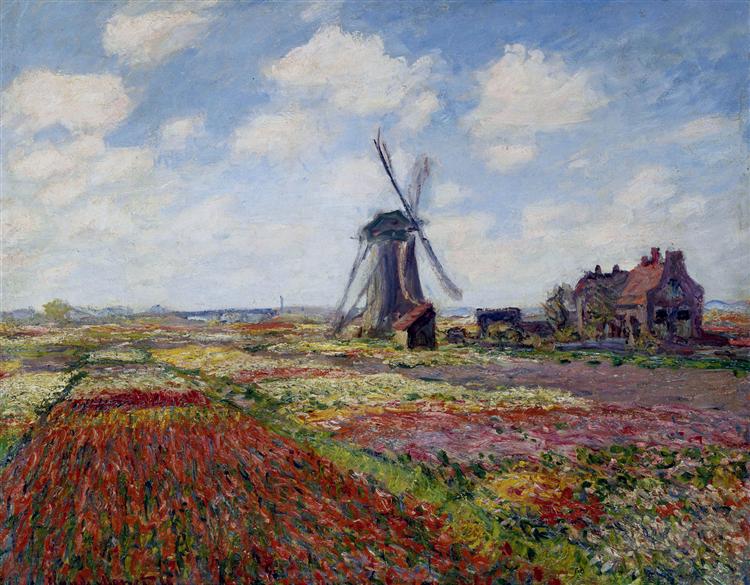Description
The painting "Tulipanes fields with the Rijnsburg wind mill", made by Claude Monet in 1886, is a work that encapsulates the very essence of impressionist perception, where color and light are protagonists in a Dutch landscape vibrant. In this work, Monet offers a light and ethereal representation of a tulips field, where the massive flowering of these vibrant colors is nuanced by the figure of the wind mill in the background, an iconic symbol of the Dutch rural landscape.
The composition of the paint is a masterful interface between the colorful fields of color and the architectural structure of the mill. Monet, as in many of his works, uses the diagonals and field depth to guide the viewer's view through the scene. The tulips, arranged in a vibrant tapestry that goes from red to yellow, creating an effect of movement and life, fill the entire foreground of the work. This close approach gives the painting an almost tangible immediacy, where the viewer can almost feel the freshness of the air and the perfume of flowers.
Although the work lacks human figures, the void effectively fills the presence of the wind mill, which stands as a silent landscape guard. This mill not only provides a visual anchor point, but also evokes a connection with the Dutch tradition, remembering the viewer that the Dutch landscape has been molded by the interaction of man with nature for centuries. The interaction between heaven and earth is equally significant; Monet handles a palette that flows with tones of soft sky blue and spongy white that contrast gently with the vivid colors of the flowers.
The loose and gestural brushstroke, characteristic of the impressionist style, is manifested in this work, providing texture and life to each element. The flowers are built with touches of color that capture the light in a way that suggests movement, almost as if the wind was gently stirring the tulips. This technique highlights temporality, offering a fleeting capture of a specific moment in nature, in line with the maximum of the impressionism of capturing the "impression" of a particular moment.
Beyond being a simple aesthetic representation, "Tulipanes fields with the Rijnsburg wind mill" reflects Monet's interest in landscapes that could synthesize not only natural beauty, but also the spectator's perceptual experience. In a context of artistic movement towards the capture of light and atmosphere, this work is emblematic of Monet's interest in the changing effects of the landscape at different times of the day and in different stations of the year.
Claude Monet, one of the founders of the Impressionist Movement, dedicated his career to representing the light and ephemeral reality of nature. This painting, In particular, it can be seen as part of its broader exploration of the interaction between man and its surroundings. With the affinity for experimentation, Monet makes this work align with his need to capture a personal and subjective vision of the world. Thus, the painting It not only stands as a masterpiece for its technique and aesthetics, but also because of the way it invites the viewer to experience an emotional connection with nature, art and time that flows.
KUADROS ©, a famous paint on your wall.
Hand-made oil painting reproductions, with the quality of professional artists and the distinctive seal of KUADROS ©.
Reproduction service paintings With a guarantee of satisfaction. If you are not completely satisfied with the replica of your painting, we refund your money 100%.

